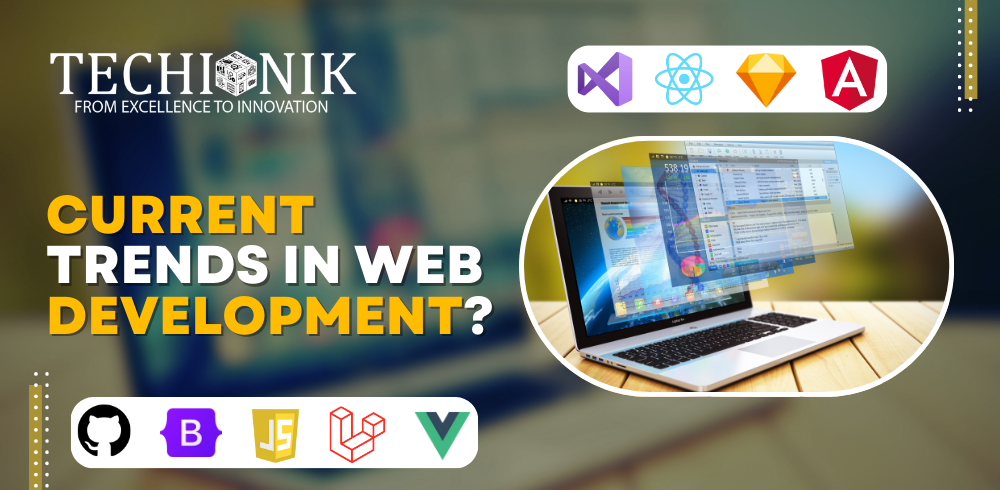Home / Blog

Web development is the cornerstone that shapes our online experiences. As we delve into 2023, the world of web development continues to witness dynamic shifts and transformative trends that redefine the way we interact with the digital realm. In this blog, we'll take a closer look at some of the current trends in web development, exploring how they impact the way websites are built and experienced.
Responsive web design remains a non-negotiable aspect of modern web development. As users access websites from a collection of devices, from smartphones to tablets and desktops, developers are tasked with creating designs that seamlessly adapt to different screen sizes. The focus is not just on aesthetics but also on user experience, ensuring that content remains accessible and readable across diverse platforms.
Progressive Web Apps represent a fusion of the best elements of web and mobile applications. PWAs offer users a fast and immersive experience, similar to native apps while maintaining the accessibility and reach of traditional websites. This trend is gaining momentum as businesses seek to provide users with a seamless, app-like experience without the need for installation.
Single Page Applications have become a staple in the web development landscape. Unlike traditional multi-page websites, SPAs load a single HTML page and dynamically update content as the user interacts with the app. This results in a smoother and more fluid user experience, minimizing page reloads and providing a more responsive feel akin to desktop applications.
WebAssembly (Wasm) is a game-changer in the realm of web development. It allows the developers to compose code in languages like C++ and Rust, which can then be compiled to run in the browser at near-native speed. This opens up possibilities for high-performance web applications, enabling complex tasks and computations that were once reserved for native applications.
Serverless architecture is revolutionizing and transforming the way web applications are deployed and managed. With serverless computing, developers can focus and concentrate on writing code without the pressure of managing servers. This not only enhances scalability but also improves efficiency and reduces costs, as resources are allocated dynamically based on demand.
JAMstack (JavaScript, APIs, and Markup) has emerged as a famous architecture for modern web development. It advocates for decoupling the front end and back end, relying on APIs to connect the two. This approach enhances security, improves performance, and simplifies the development process by leveraging pre-built markup served through a content delivery network (CDN).
Traditional Content Management Systems (CMS) are giving way to headless CMS, providing developers with greater flexibility in managing content. By decoupling the content from the production layer, developers can deliver content to various platforms and devices effortlessly. This modular approach facilitates collaboration among development teams and accelerates the pace of content updates.
Inclusivity is a driving force in contemporary web development. Web accessibility standards are gaining prominence, urging developers to assemble websites that are functional for people of all abilities. This involves designing interfaces that can be navigated using screen readers, ensuring colour contrasts for visibility, and implementing other practices that enhance the overall accessibility of websites.
Motion UI is becoming a focal point in web design, adding a layer of interactivity and engagement. Subtle animations and transitions not only make websites visually appealing but also contribute to a more intuitive user experience. From micro-interactions to page transitions, motion UI is a powerful tool for conveying information and guiding users through a website.
With the rising complexity of cyber threats, cybersecurity is a paramount concern in web development. Developers are incorporating robust security measures, including HTTPS adoption, secure coding practices, and regular security audits. Prioritizing cybersecurity is crucial not only for protecting user data but also for maintaining trust in an era where online threats are ever-present.
As we traverse the diverse landscape of current web development trends, it's evident that the industry is in a perpetual state of innovation. From responsive designs that cater to varied devices to the rise of PWAs and the transformative power of WebAssembly, developers are navigating uncharted territories to create digital experiences that are not only functional but also delightful.
In this ever-evolving digital ecosystem, the key lies in adaptability. As developers embrace these trends, they not only enhance the capabilities of web applications but also contribute to a more prosperous and more accessible online world. The future of web development is dynamic, promising continued evolution and innovation, making the journey through the digital realm an exciting and ever-changing adventure.